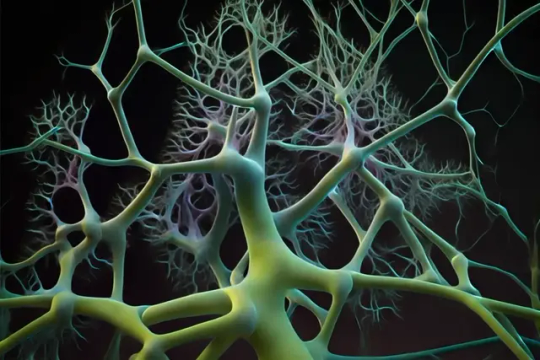#GraphConvolutionalNetworks
Explore tagged Tumblr posts
Text
Graph Neural Networks: Revolutionizing Data Analysis in Graph-Structured Domains

Graph Neural Networks (GNNs) represent a paradigm shift in the realm of neural networks, uniquely tailored for graph-structured data. They are pivotal in addressing complex data scenarios where traditional neural networks fall short. This comprehensive article delves into the core functionalities, applications, and future potential of GNNs.
Understanding Graph Neural Networks
Direct Application to Graphs GNNs' foremost strength lies in their direct application to graphs, facilitating node-level, edge-level, and graph-level prediction tasks. This flexibility proves invaluable across various fields where data is intrinsically relational, such as analyzing social networks, understanding molecular structures, and optimizing communication networks . Processing Complex Graph-Structured Data GNNs excel at processing and analyzing intricate graph-structured data. This capacity unlocks new avenues in numerous domains, including network analysis, computational biology, and the development of advanced recommender systems . Dependence on Graph Structure Central to GNNs' functionality is their ability to capture the dependence of graphs through message passing between nodes. By leveraging the inherent structural information of graphs, GNNs can make more accurate predictions and analyses, a critical aspect in fields like network security and structural health monitoring .
Expansive Applications of GNNs
Versatility in Various Fields GNNs' adaptability to graph data makes them invaluable in areas where relationships and connections are crucial. This includes, but is not limited to, social network analysis, drug discovery and chemistry, traffic flow prediction, and biological network analysis . From Foundations to Frontiers Spanning from basic concepts to cutting-edge advancements, GNNs are continually evolving. Ongoing research and development are likely to amplify their capabilities, making them even more effective in handling diverse, graph-related challenges .
How can Graph Neural Networks be used in Generative Art?
Graph Neural Networks (GNNs) have significant potential in the realm of generative art, leveraging their unique capabilities in understanding and manipulating graph-structured data. Here are some ways GNNs can be applied in this field: - Modeling Complex Relationships: GNNs can model intricate relationships and patterns within data. In generative art, they can analyze the structure of artistic elements, like color, form, and composition, to generate new artworks that maintain stylistic coherence or offer novel artistic interpretations. - Link Prediction for Artistic Elements: GNNs are adept at inferring missing links or detecting spurious ones in graph data. This capability can be used in generative art to predict and create connections between different artistic elements, leading to the generation of visually cohesive and complex artworks . - Learning Node Embeddings: In the context of generative art, GNNs can learn embeddings (representations) of various artistic elements. These embeddings can capture the nuances of style, technique, and other artistic features, which can then be used to generate new art pieces that reflect certain styles or artistic trends . - Message Passing for Artistic Interpretation: GNNs use message passing to understand graph structures, which can be applied to the way different elements in an artwork relate to each other. This can help in creating art that dynamically changes or evolves based on certain rules or inputs, adding an interactive or adaptive element to the artwork .
Python code example of a Graph Neural Networks
Here's a basic example of implementing a Graph Neural Network (GNN) using PyTorch. This code demonstrates the creation of a simple GNN for node classification on a graph: import torch import torch.nn as nn import torch.nn.functional as F from torch_geometric.nn import GCNConv # Define a simple GNN model class GCN(nn.Module): def __init__(self, num_features, num_classes): super(GCN, self).__init__() self.conv1 = GCNConv(num_features, 16) self.conv2 = GCNConv(16, num_classes) def forward(self, data): x, edge_index = data.x, data.edge_index # First Graph Convolutional Layer x = self.conv1(x, edge_index) x = F.relu(x) x = F.dropout(x, training=self.training) # Second Graph Convolutional Layer x = self.conv2(x, edge_index) return F.log_softmax(x, dim=1) # Example usage num_features = 10 # Number of features per node num_classes = 3 # Number of classes for classification model = GCN(num_features, num_classes) This code defines a simple two-layer Graph Convolutional Network (GCN) using PyTorch and PyTorch Geometric. The model takes in the number of features per node and the number of classes for classification. Each convolutional layer (GCNConv) in the network processes the graph data, applying a graph convolution followed by a ReLU activation and dropout. Note: This is a basic example. For a real-world application, you would need to provide graph data (nodes, edges, node features) to the model and train it on a specific task like node classification, link prediction, etc.
🌐 Sources
- AssemblyAI - AI trends in 2023: Graph Neural Networks - ScienceDirect - Graph neural networks: A review of methods and applications - arXiv - Generative Graph Neural Networks for Link Prediction - YouTube - AI Explained: Graph Neural Networks and Generative AI - Medium - Top Applications of Graph Neural Networks 2021 - Towards Data Science - Applications of Graph Neural Networks - XenonStack - Graph Neural Network Applications and its Future - arXiv - Graph Neural Networks: Methods, Applications, and - neptune.ai - Graph Neural Network and Some of GNN Applications - sciencedirect.com - Graph neural networks: A review of methods and applications - frontiersin.org - Graph Neural Networks and Their Current Applications in - Jonathan Hui - Applications of Graph Neural Networks (GNN) - Medium - GNN python code in Keras and pytorch - Towards Data Science - How to Create a Graph Neural Network in Python - DataCamp - A Comprehensive Introduction to Graph Neural Networks - GitHub - Hands-On-Graph-Neural-Networks-Using-Python - Towards Data Science - Graph Neural Networks in Python - Analytics Vidhya - Getting Started with Graph Neural Networks Read the full article
#DataAggregation#Deeplearning#Edge-levelPrediction#GNNApplications#GraphConvolutionalNetworks#GraphNeuralNetworks#Graph-levelPrediction#NetworkAnalysis#Node-levelPrediction#Non-EuclideanData
0 notes